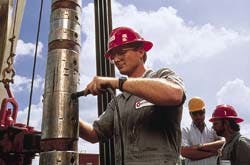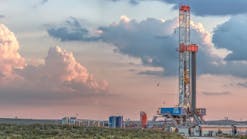Keith Rappold
Drilling Editor
Many LWD tools can now produce wire line quality logs, including the standard triple combo. The triple combo logs typically measure caliper and gamma ray, resistivity, density, and neutron porosity.
Because of the growing number of horizontal and extended reach wells being drilled, the LWD market should stay strong for some time.
Operators have long been familiar with running and interpreting wire line logs. However, some formation evaluation measurement while drilling (MWD) tools measure downhole properties differently than standard wire line tools, thus requiring different interpretation techniques. Understanding the differences between these two types of logging tools will allow an operator to substitute LWD for wire line logs more effectively.
Some operators are still uncomfortable with LWD and also run open hole wire line logs after the well is drilled. These subsequent wire line logs are often referred to as measurement after drilling (MAD). Such wire line logs are run to provide insurance or backup logs and assess any changes in fluid invasion into the formation over time.
LWD technology has advanced significantly in the past couple of years, making the logs equivalent in quality to wire line logs in many cases. As operators become more familiar with running the LWD tools and interpreting the logs, they may no longer require wire line backup logs.
LWD market potential
None of the major service companies or operators expects LWD to completely replace open hole wire line logging.
LWD tools are used mainly in horizontal and extended reach wells, in wells that require precise trajectoriesusually horizontal sections, in wells where there is some chance wire line logging will not be possible, and in wells that require immediate decisions on changing trajectory.
One service company estimates the wire line logging industry to be about $2.2 billion/year, whereas the MWD market is only about $600-700 million/year. Of that amount, formation evaluation while drilling is about $350 million, and the remainder consists of directional and gamma ray measurement while drilling.
MWD tools are used most often in the Gulf of Mexico and North Sea and to a lesser extent in Africa, the Far East, South America, and the Middle East. One company estimates half the LWD market is in North America and half in the rest of the world.
LWD applications
In most vertical and onshore wells, wire line logging is still more economical than LWD.
In the Gulf of Mexico, for example, taking formation evaluation measurements while drilling may eliminate a couple of days of wire line logging. Cutting 2 days from a 10-20 day drilling operation results in significant savings.
In the North Sea, where drilling operations may last 100 or more days, saving a couple of rig days by using LWD is not as significant, considering the LWD tools may be used for many more days than would have been otherwise spent on wire line logging. The value, however, lies in the real-time measurements that allow a well to be steered very efficiently through a pay zone.
In many horizontal or extended reach wells it is impossible or impractical to run conventional wire line logs. In high angle wells, standard wire line tools have to be pumped down or conveyed on pipe. Reaching bottom can be time consuming and difficult in many cases.
The LWD tools, however, are placed in the drilling bottomhole assembly. These tools take formation measurements as soon as the formation is drilled, before drilling fluid can invade the formation.
Currently available LWD tools can work in hole sizes as small as 6 in. and as big as 1712 in. or larger. The majority of LWD tools, however, are used in standard 812 in. or 1212 in. holes.
A general trend is the development of smaller diameter tools, although there are many technical hurdles to overcome. The challenge is a combination of physics and mechanics. The smaller tools must perform all the logging measurements in standard format yet remain robust and work properly as a drill collar.
A greater variety of wire line tools is increasingly available and in much smaller sizes.
LWD advantages
The wire line connection allows a tremendous data transmission rate to the surface compared with that of MWD tools.
MWD tools typically use mud pulse telemetrypositive pulse, negative pulse, or continuous carrier wavesto send data back to the surface. More data are collected than can be sent to the surface, so much of the information must be stored downhole in computer memory chips inside the tools. These stored data are usually read from memory when the tool is at surface or transmitted from downhole when convenient.
Recent advances in data transmission technology have improved the real-time use of LWD tools by allowing more of the necessary measurements to be sent to surface. As a result of advances in processing technology and data interpretation, only certain necessary information is sent to surface in real time.
These real-time logs are used mainly for geological interpretation for immediate decisions on well trajectory. The remaining data are retrieved from the tool later, after it has been tripped to surface. The full data are then processed to produce a complete log, comparable in quality to wire line.
MWD tools are powered either by batteries or by a downhole turbine. Most batteries can last about 200 hr under downhole conditions, and this amount of time is usually more than enough for most bit runs. Most downhole memory also holds as much as 200 hr of logging data. Turbine motors, in contrast, power MWD tools only when the drilling fluid is being circulated.
In general, measurement while drilling refers to directional and gamma ray measurements useful for surveying, directional steering, and drillstring mechanics. In contrast, logging while drilling refers to formation evaluation measurements similar to those in the triple combo.
MWD tools typically measure well bore inclination, azimuth, toolface orientation, directional gamma ray, and short normal resistivity. Other MWD tools measure torque, weight, vibration, and shock loads.
Resistivity
MWD applications for the 16 in. short normal resistivity tools qualitatively indicate the boundaries between oil filled sands and shales or water sands. These logs can detect hydrocarbon zones, help estimate pore pressure in undercompacted shales, and help pick coring and casing points.
The 16 in. short normal tool measures formation resistivity with a receiver spaced 16 in. from the transmitter.
The 1 and 2 MHz resistivity tools work essentially the same as the 16 in. short normal tools. The tools generally have multiple spaced transmitters and receivers that allow several depths of investigation into the formation.
Most LWD resistivity tools are now borehole compensated. In other words, at least two transmitters are used to minimize the effect of borehole irregularities on the resistivity log.
These tools emit a wave from a transmitter and then measure the phase shift and attenuation between signals detected at several receivers. These measurements are then translated into resistivities.
The phase difference measurements generally have a smaller depth of investigation than the attenuation measurements but better vertical resolution.
The latest LWD resistivity tools offer multiple depths of investigation with several transmitters and several receivers spaced at specific intervals along the tool. Each major service company offers some variety of LWD tool that takes multiple resistivity measurements.
The multiple depth of investigation tools have transmitter and receiver arrays spaced for deep formation evaluation, invasion detection, and improved accuracy at higher resistivities.
The 2 MHz tools also provide quantitative petrophysics in water and oil based muds. These logs can generally be integrated with standard wire line logs. Multiple depths of investigation improve well bore placement and the time lapse identification of moveable fluids.
Resistivity measurements made while drilling can be compared with wire line resistivity measurements made several days later to identify any movement of fluid into the formation. The LWD measurements are less affected by fluid invasion than are the wire line measurements. Wire line measurements may be impaired by deep invasion and may require corrections to determine true resistivity. The LWD 2 MHz measurements are very close to true resistivity.
In thin beds, phase shift resistivity is closer to true resistivity. In very thin beds, a thin bed correction must be applied to LWD and wire line resistivities to obtain true resistivity. Some standard wire line induction measurements may not resolve very thin beds.
Some compensated resistivity tools are now available with a 412 in. diameter for 578 in. to 612 in. slim hole drilling operations.
Geosteering
Traditional directional drilling techniques focus on geometrical steering, or accurately placing a well within a fixed three dimensional target. Modern techniques focus on geological steering (geosteering) where the well objective is to maximize reservoir exposure.
Common targets include drilling high angle or horizontal wells along thin beds or, in thicker beds, maintaining the well at a specified distance from some interfacesuch as below the top of the reservoir or above an oil/water interface.
One company estimates horizontal wells in general only have about 50-60% of the lateral section inside the pay zone. The wells are acceptable because they produce much better than offset vertical wells.
The production should be even greater if most of the lateral section were drilled optimally through the reservoir pay zone. This consideration has been one of the drivers behind the increased use of geosteering. Nearly 100% of the geosteering applications are in horizontal wells.
Although several types of resistivity sensors are used for geosteering, the most effective is propagation resistivity. This provides a quantitative measurement, works in all types of mud, and has a suitable depth of investigation for detecting bed boundaries.
Based on resistivity measurements received in real time, the driller can steer the bottomhole assembly up or down to keep the well path from exiting a thin pay zone. In the past, pilot holes were drilled through the formation to obtain true hydrocarbon contacts and bed boundaries. With geosteering, many operators now eliminate costly pilot holes and instead drill directly into the formation by using real time resistivity information to detect boundaries.
LWD resistivity gamma ray tools take measurements at the bit or closer to the bit than conventional LWD assemblies with the resistivity tool about 30 ft behind the bit. Several commercially available tools can provide resistivity measurements at the bit or within a few feet of the bit. This location for measurements is ideal for detecting bed boundaries quickly. The drawback is that some of the measurements are limited because of the difficulty in placing instruments ahead of the mud motor and just behind the bit.
At-the-bit and near-bit sensors may include resistivity, inclination, and gamma ray. These tools generally have shallow depths of investigation that allow for rapid recognition of stratigraphic features. This information can quickly tell the engineer where the bit is and where the well is headed.
Resistivity log responses in high angle wells are quite different from those in similar vertical wells. A key to geosteering is accurate modeling of the expected log response. As the well is drilled, the LWD resistivity measurements are compared with the modeled log, and the well course can be adjusted accordingly.
Neutron porosity
The LWD porosity tools have a chemical source that generates neutrons that scatter into the formation. Hydrogen nuclei in water and hydrocarbons slow the neutrons, and various elements capture the slowed neutrons. When a neutron is captured, a gamma ray is emitted.
The slowed neutrons and capture gamma rays are then detected by near and far detectors (relative to the location of the neutron source on the tool). The use of two detectors allows compensation for borehole effects.
Neutron porosity tools are typically used alone or with formation density tools to determine formation porosity. The normalized count rates from the near and far detectors can be used to distinguish gas from oil.
When LWD neutron porosity are combined with density tool measurements, cross plots can be used to determine rock type. Crossover of the logs can indicate the presence of gas.
One limitation of these tools is the shallow depth of investigation, which increases the measurements sensitivity to borehole washouts. Because the measurements are taken soon after drilling, however, this problem can be less of a factor than with wire line logs taken days later. Another limitation is the difficulty in interpreting some logs if the clay materials in a formation contain hydrogen bound in water.
The technical challenge with neutron porosity tools is to obtain an accurate correction for the standoff between the tool and the borehole wall. Each service company has a slightly different method of correcting for standoff errors.
One method uses acoustic calipers to check for standoff, and data are not collected when the standoff exceeds a tolerable limit. Another method uses sensors placed on stabilizer blades that remain in contact with the borehole.
Another tool takes measurements from several quadrants and analyzes the data to determine the accurate porosity measurement. In effect, the tool measures azimuthal porosity. The azimuthal information from nuclear measurements while drilling can provide additional information on formation heterogeneity and bed boundary definition.
With these means to keep the sensors pressed against the borehole and with standoff corrections, many of the LWD neutron porosity tools can obtain more accurate measurements than wire line counterparts.
Formation density
The formation density LWD tools use a chemical source to generate gamma radiation that is focused into the formation.
The gamma rays collide with electrons in the formation and are scattered, losing energy and becoming absorbed. The formation density tools are used to estimate pore pressure and, in combination with neutron porosity tools, to determine rock type or the presence of gas.
Near and far detectors measure the number of gamma rays received. The number of gamma rays measured is a function of the density of electrons in the formation, which is about proportional to the density of the formation. The use of two detectors allows corrections for mud cake and small irregularities in borehole smoothness.
The tools very shallow depth of investigation is a limitation making the measurements sensitive to thick mud cakes, washouts, and large borehole sizes.
The most critical variable in LWD density measurements, as in neutron porosity measurements, is standoff. Standoff is usually eliminated as a variable in wire line logging by pressing the tool against the formation with a backup arm.
Standoff is unavoidable with LWD tools, although its effects can be substantially reduced through use of a stabilizer blade. Corrections for small or moderate standoffs may be obtained by comparing long and short spaced detector responses. When the standoff becomes too largegreater than 1 in.statistical methods are used to correct or discard the data.
One LWD tool, termed an azimuthal density neutron tool, measures borehole-compensated formation density, neutron porosity, photoelectric factor, and ultrasonic standoffs. The tool takes these measurements in four quadrants around the borehole and an average around the borehole. These multiple readings help eliminate errors from standoff problems.
Some of the new LWD density tools are being designed as more driller friendly. Past tool designs focused strictly on the measurements taken and not on how the tool fit into the desired bottomhole assembly configuration. The new tools are stronger and have slightly undergauge stabilizers and sleeves.
Acoustic tools
During drilling, ultrasonic LWD tools acquire acoustic waveforms from which high quality compressional transit times are extracted. For one commercial tool, the data are typically recorded in downhole memory, but the transit times can be sent to surface in real time to help determine formation porosity, evaluate lithology, and estimate pore pressure.
Ultrasonic data are used to improve density and neutron porosity measurements obtained in real time. The ultrasonic transducers measure borehole caliper and tool standoff. These data are used to correct the density and neutron porosity measurements, either immediately or through computer processing later on the surface.
The caliper information can help drillers detect borehole instabilities and estimate the amount of cement required in the annulus later when casing is set.
Wire line tools, in comparison, use mechanical fingers for a physical measurement of the borehole caliper. Such mechanical devices could break during harsh drilling conditions.
Combining real-time sonic porosity and lithology information with resistivity and nuclear measurements made while drilling lets geologists evaluate pay zones prior to borehole or formation damage. Real-time logs of sonic transit times and resistivity help drillers to anticipate and identify overpressure zones. Drilling efficiency can then be improved by adjusting weight on bit and mud weight.
Data from LWD sonic tools can also be used to create synthetic seismograms to help relate seismic and geologic features.
In general, LWD acoustic tools for measuring compressional slowness can operate in the same frequency range as wire line acoustic tools. Drilling induced noise generally does not interfere with the operation of these sonic tools, particularly when the tool is separated from the bit by other tool assemblies.
Copyright 1995 Oil & Gas Journal. All Rights Reserved.



